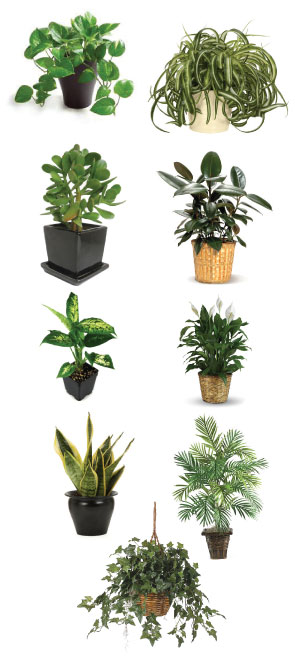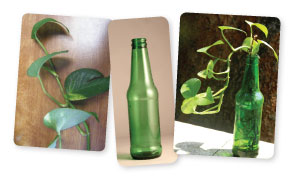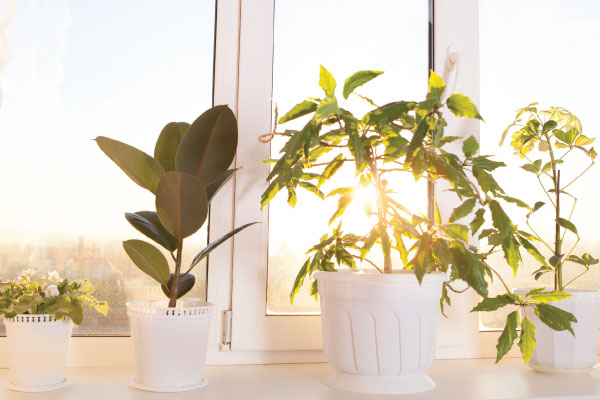The rising mercury is making us all run back indoors, but that shouldn’t mean we must wait another eight months to enjoy the soothing sight of foliage. Ankita Mamgain shares some ideas for adding a green touch to your décor.
As you clean up the pool, get your AC serviced and put your boots and coats away, how about bringing a slice of your beautiful garden indoors? In addition to lending a refreshing touch to the décor, the right combination of plants can make the space calmer, improve air quality and make the atmosphere more relaxed, stimulating
and interesting.
Studies have conclusively shown reduced stress, increased concentration and better health for those who include plants in their living environment. Some of these greens, such as aloe vera, have significant medicinal properties, which can come in handy in a variety of situations.
Be it aesthetic, physical or mental benefits, a little foliage can have a lasting affect on your wellbeing.
STYLISH AND STURDY
When we say “bring the outside, in,” remember to make a practical selection of which plants like the indoor space and do not require feverish, round-the-clock attention. Here are some specimens that can famously survive neglect as well as an obsessive nurturer:

Pothos: This plant is the ultimate survivor and is known for its air-purifying qualities. Its trailing stems work well in a hanging basket or as a climber with support from any object it can find nearby. An array of lighting and temperature conditions will work for it, however you must allow soil to dry up a little between waterings.
Spider Plant: In addition to being strong they add visual interest to a room and have remained in vogue for years. These do well in hanging pots with evenly moist soil and bright or medium light conditions.
Jade Plant: The thick, lush leaves and visually interesting branches grow slowly but have the potential to live for decades. Put them in a colourful pot next to the window and just let them be. The succulent leaves do not need a lot of water and prefer ordinary room temperatures.
Rubber Tree: This is an easy to care for plant, capable of growing up to 2.4m tall, which can be tamed by regular pruning. Let the top soil dry out between waterings and position in bright to medium light conditions.
Dieffenbachia: The leaves can grow up to 30cm long and will add a tropical look to your décor. Keep the room temperature normal and soil evenly moist with low lighting conditions for best results.
Peace Lily: One of the most popular indoor plants, this one looks delicate but can survive under the harshest of conditions. Again one of the most potent natural air purifiers, it has dark leaves with beautiful white flowers. Give it low humidity, low light and evenly moist soil.
Snake Plant: There can’t possibly be an easier to handle plant than this one. Commonly known as Mother-in-Law’s Tongue, it has variegated leaves that grow upright and have yellow or white edges. It enjoys somewhat dry air and soil and normal temperatures.
Areca Palm: This beautiful plant can immediately spruce up any large room or hallway. It usually adorns corners, adding green accents to the space. Give it indirect light, somewhat dry soil and water every other week.
IN THE RIGHT PLACE
There are no hard and fast rules on adding plants to your décor, however, the size of the room and availability of light should be considered. The scale and proportion play an important role as well. A big plant is usually not advisable for a small room. However, an attractive lager shrub can round off an awkward corner or help conceal an unwanted fixture.
Try hanging tall climbers and runners in a basket in high ceilinged spaces with an arrangement of smaller bushes. The combination with taller plants beautifies a large room.
Do It Yourself
 Here’re our tips on growing Epipremnum Aureum, Pothos, Money Plant or Devil’s Ivy in the house. They’re all low maintenance and add a fabulous green touch.
Here’re our tips on growing Epipremnum Aureum, Pothos, Money Plant or Devil’s Ivy in the house. They’re all low maintenance and add a fabulous green touch.
1. Get any old glass bottles and fill them 2/3 with water.
2. Just drop a stem in and let the plant grow.
3. Change the water every two to three weeks.
4. You can place the bottles on shelves or make attractive arrangements.



































Where can i view this place ? Do they have a showroom or any contact number.
Thanks
Comments are closed.